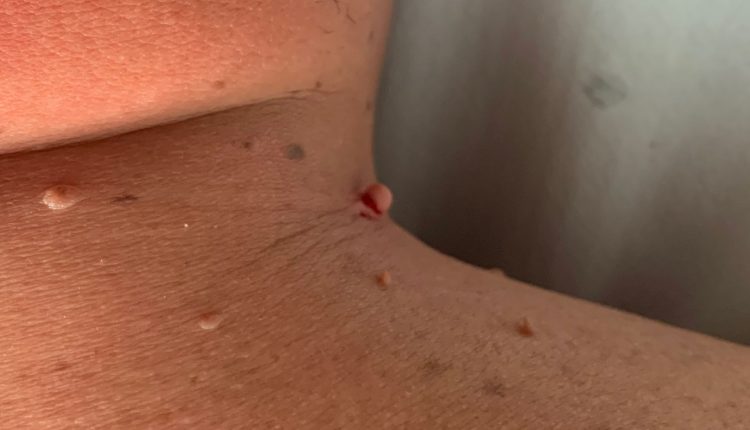
How to eliminate pendulous fibroids
Pendulous fibroids (vulgarly called warts) are benign skin excrescences that can affect as many as 1 in 2 people in a lifetime, regardless of gender, with a slight predominance in women after menopause
Generally harmless, painless and absolutely non-contagious, in cases where it is bothersome it can be removed with minor outpatient surgery.
Why pendulous fibroma forms
Also known as acrochordon or vulgarly as porro, pendulous fibroma is formed by an overgrowth of certain cells in the dermis, called fibroblasts.
Its size can range from millimetres to several centimetres due to a slow and progressive growth due to the force of gravity pulling them downwards, causing them to hang from their site of origin, hence the term pendulous.
The areas of the body most frequently affected
The areas most affected by the appearance of fibroids are those where the skin has folds, such as:
- eyelids;
- groin and armpits;
- neck.
The causes
The cause of this abnormal growth is a chronic inflammatory stimulus.
The origin of this inflammatory stimulus may come from outside, such as from rubbing a necklace or bra, or from rubbing the skin folds (folds) in the groin or axilla.
However, since these are benign neoformations, not much scientific research has been devoted to the aetiopathogenesis of this pathology and therefore the causes are not certain.
Factors that may favour the appearance of pendulous fibroids, in addition to chafing, are:
- age;
- hormonal factors;
- overweight and obesity;
- dyslipidaemia, i.e. changes in the amount of lipids, or fats, in the blood, particularly triglycerides and cholesterol;
- diabetes.
A genetic predisposition probably also plays a role: it is not uncommon to see several members of the same family affected by this problem.
Can pendulous fibroma develop into malignancy?
Pendulous fibroma, or often pendulous fibromas, since several of them frequently form in the same area, are benign, non-contagious neoformations, and the possibility of malignant evolution is almost non-existent.
They can, however, cause a significant aesthetic impact and a feeling of discomfort.
In addition, they can bleed, for example, when they are bumped by a bra or injured by a razor during shaving, with the risk of skin infection at the site of the trauma.
Removal of pendulous fibroids: when it is indicated and how it is done
The removal of one or more pendulous fibroids may be indicated if the problem has an impact on quality of life, both from an aesthetic and a ‘functional’ point of view.
It is an outpatient procedure, possibly under local anaesthesia if the base of the fibroid is large.
The removal, always preceded by disinfection of the fibroma site, can be performed, depending on the site and size of the fibroma, with different techniques
- sterile scalpel blade;
- an energy scalpel, also known as a diathermocoagulator, which makes it possible to ‘burn’ the fibroma in just a few seconds, immediately resolving the problem. Usually no stitches are needed, except in the case of large fibroids, for which virtually no scar remains;
- cryotherapy, whereby the fibroma is frozen at the root, through the application of liquid nitrogen, causing necrosis (death) of the fibroma itself, which will fall out spontaneously within a couple of weeks’.
The removal may involve 1 or more fibromas in the same session and should be scheduled at a time when sun exposure of the area can be limited for the first few days.
Removing pendulous fibroids at home: no DIY
Do-it-yourself’ is not recommended for removing fibroids.
The home remedy of tying off the fibroid with a sewing thread is very common, but although apparently effective (by blocking the blood flow, the fibroid should dry out and fall out on its own after a few days) it exposes the patient to a higher risk of recurrence and can give an aesthetically unpleasant result.
How to prevent pendulous fibroids
The weapons available to prevent pendulous fibroids are:
- adequate hydration
- weight loss in overweight persons;
- limiting the possibility of rubbing against everyday objects (bracelets, necklaces, etc.).
Read Also:
Emergency Live Even More…Live: Download The New Free App Of Your Newspaper For IOS And Android
Epidermolysis Bullosa And Skin Cancers: Diagnosis And Treatment
Skin: What To Do In Case Of Folliculitis?
Childhood Psoriasis: What It Is, What The Symptoms Are And How To Treat It
Dermatological Examination For Checking Moles: When To Do It
Melanoma: Prevention And Dermatological Examinations Are Essential Against Skin Cancer
Cupping, The Pain Relief Therapy Applied To The Skin



